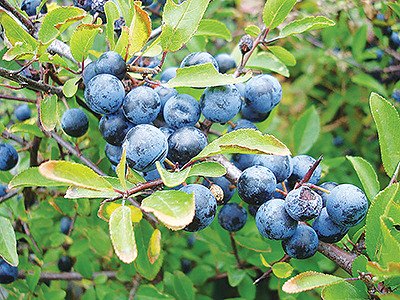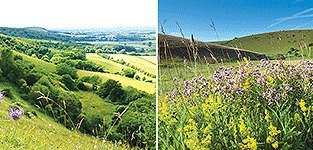Sussex Wildlife Trust: Blackthorn
October 1st, 2021 Each spring the blackthorn hedges bloom, their brilliant white flowers blanket the countryside temporarily creating snow-white drifts against the woodlands and along our roadsides.
Each spring the blackthorn hedges bloom, their brilliant white flowers blanket the countryside temporarily creating snow-white drifts against the woodlands and along our roadsides.From up there it felt like I could see the whole world: the oak trees adorned in summer’s fading leaves, the fields at harvest, the city far in the distance. Each October my Grandad would load me and a bucket into Betsy, his faithful 1963 Ford Anglia. Together we’d cruise the county’s back roads. Every few miles he would ease Betsy to a halt and inspect the landscape until finally declaring ‘this is the place’.
My bucket and me would be hoisted high up on his shoulders and from there I’d get my Grandad-stand view of the world. More importantly though it’d put me within reach of the treasure. The jewels we sought on our expeditions were sloes, the round purple-black berries that bedecked the blackthorn bushes. My Grandad was convinced that the finest fruits were located high on the hedge. And the best sloes made the best sloe gin.
Each spring the blackthorn hedges bloom, their brilliant white flowers blanket the countryside temporarily creating snow-white drifts against the woodlands and along our roadsides. These ephemeral petals soon fall and the blackthorn becomes cloaked with small, oval leaves capturing the energy which powers production of the sloes.
A blackthorn bush is a prickly character and as approachable as an enraged porcupine. Each twig is armed with spikes which deter cattle and Grandads from helping themselves to its leaves and berries. This spiny spinney fortress also safeguards a wealth of wildlife.
Nightingales, Turtle Doves and other birds nest under its protection and the elusive Brown Hairstreak butterfly lays its miniature sea urchin-like eggs on the bush’s black bark.
Many years after my Grandad and Betsy had departed, I decided to honour them both and concoct my own sloe gin. I found an online recipe and, in what was and still remains one of the biggest disappoints of my adult life, I discovered that the main ingredient in sloe gin… was gin.
After watching my Grandad making his moonshine I had genuinely believed that by submerging a load of berries in a bottle you would magically turn water into gin.
It seems my Grandad couldn’t perform miracles, indeed looking back our hedgerow pillaging raids could easily be dismissed as forced child labour. Was he exploiting me and my tiny hands to bypass those thorns and reach the best berries?
A few decades earlier he’d probably have sent me down a mine or up a chimney. But my Grandad wasn’t some Fagin-like character.
Now I think of it I never once saw him actually drinking any of his sloe gin. Perhaps just being out in the countryside in the autumn sunshine on an adventure with Betsy and his grandson was the truly intoxicating ingredient.
By Michael Blencowe: Learning & Engagement Officer, Sussex Wildlife Trust
Sussex Wildlife Trust is an independent registered charity caring for wildlife and habitats throughout Sussex. Join Michael Blencowe on our regular wildlife walks and also enjoy free events, discounts on wildlife courses, Wildlife magazine and our guide book: Discovering Wildlife in Sussex. It’s easy to join online at:
www.sussexwildlifetrust.org.uk/join
or T: 01273 497532.
My bucket and me would be hoisted high up on his shoulders and from there I’d get my Grandad-stand view of the world. More importantly though it’d put me within reach of the treasure. The jewels we sought on our expeditions were sloes, the round purple-black berries that bedecked the blackthorn bushes. My Grandad was convinced that the finest fruits were located high on the hedge. And the best sloes made the best sloe gin.
Each spring the blackthorn hedges bloom, their brilliant white flowers blanket the countryside temporarily creating snow-white drifts against the woodlands and along our roadsides. These ephemeral petals soon fall and the blackthorn becomes cloaked with small, oval leaves capturing the energy which powers production of the sloes.
A blackthorn bush is a prickly character and as approachable as an enraged porcupine. Each twig is armed with spikes which deter cattle and Grandads from helping themselves to its leaves and berries. This spiny spinney fortress also safeguards a wealth of wildlife.
Nightingales, Turtle Doves and other birds nest under its protection and the elusive Brown Hairstreak butterfly lays its miniature sea urchin-like eggs on the bush’s black bark.
Many years after my Grandad and Betsy had departed, I decided to honour them both and concoct my own sloe gin. I found an online recipe and, in what was and still remains one of the biggest disappoints of my adult life, I discovered that the main ingredient in sloe gin… was gin.
After watching my Grandad making his moonshine I had genuinely believed that by submerging a load of berries in a bottle you would magically turn water into gin.
It seems my Grandad couldn’t perform miracles, indeed looking back our hedgerow pillaging raids could easily be dismissed as forced child labour. Was he exploiting me and my tiny hands to bypass those thorns and reach the best berries?
A few decades earlier he’d probably have sent me down a mine or up a chimney. But my Grandad wasn’t some Fagin-like character.
Now I think of it I never once saw him actually drinking any of his sloe gin. Perhaps just being out in the countryside in the autumn sunshine on an adventure with Betsy and his grandson was the truly intoxicating ingredient.
By Michael Blencowe: Learning & Engagement Officer, Sussex Wildlife Trust
Sussex Wildlife Trust is an independent registered charity caring for wildlife and habitats throughout Sussex. Join Michael Blencowe on our regular wildlife walks and also enjoy free events, discounts on wildlife courses, Wildlife magazine and our guide book: Discovering Wildlife in Sussex. It’s easy to join online at:
www.sussexwildlifetrust.org.uk/join
or T: 01273 497532.
Comments (0)
No comments have been submitted yet.Why not be the first to send us your thoughts
Leave A Comment
Thank you for your comments, they will appear shortly once approved.
Recent Posts
Have You Seen...






